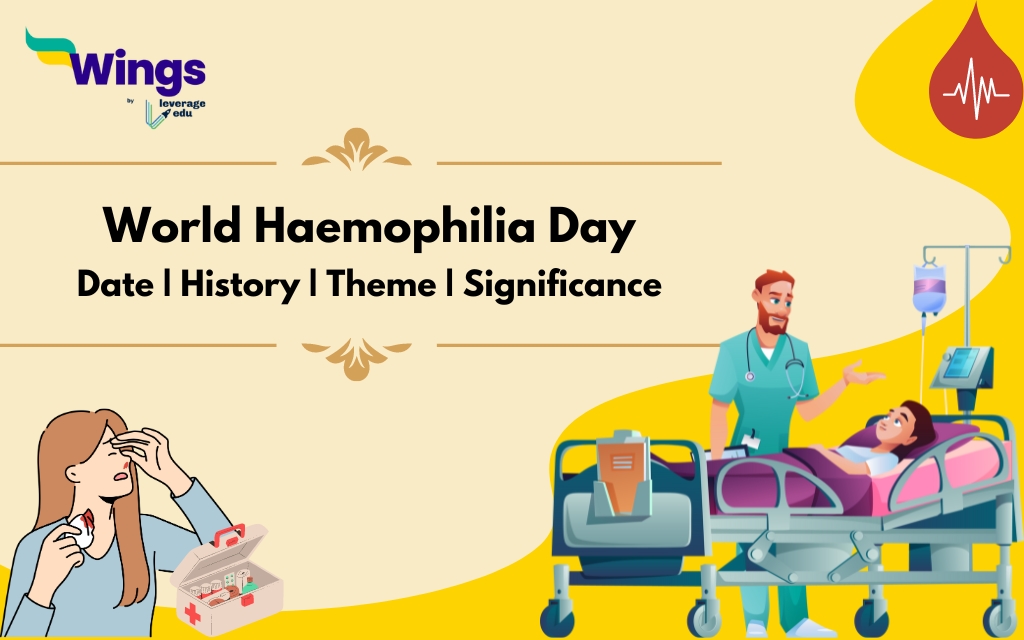World Haemophilia Day is a globally recognized event held every year on 17 April. The World Federation of Haemophilia (WFH) and the community of people with hereditary bleeding disorders have been celebrating this day since 1989. Moreover, organized in honour of Frank Schnabel, this day aims to impart awareness about the disease and ways to control and prevent bleeds of people with haemophilia. The foundation, the community, and the supporters of the community honour the journey of patients and caregivers by using the advocacy toolkit of WFH and taking part in the “Light It Up Red” campaign.
| Name of the day | World Haemophilia Day |
| Observed on | 17 April |
| Reason | To raise awareness about hereditary bleeding disorders. |
| Theme 2024 | Equitable access for all: recognizing all bleeding disorders |
Contents
History of Haemophilia
Haemophilia or “the royal disease” dates back to the 2nd century AD. It was first diagnosed among baby boys in a Jewish community. This disease later surfaced in the 10th century among the male population. In the 1100s, uncontrolled bleeding was termed Abulcasis.
In 1803, a Philadelphia physician, John Conard Otto published the first-ever article on the haemorrhagic bleeding disorder. In this article, Otto mentioned that this disorder is prominent among the male population and is hereditary. He traced this disorder to a female in New Hampshire.
In 1813, John Hay proposed that certain traits of the bleeding disorder could be transferred from an affected male to an unaffected female offspring of the man. In 1828, Dr Schonlein and Friedrich Hopff minted the term “haemorrhaphilia” to describe this condition. This term was later shortened to “haemophilia”. In 1947, a Buenos Aries-based doctor Dr Alfredo Pavlovsky identified variations in this disease and distinguished it into “Haemophilia A and Haemophilia B”.
Also Read: World Autism Day
History of World Haemophilia Day
The World Federation of Hemophilia instituted World Haemophilia Day in 1989 to raise awareness about haemophilia and other bleeding disorders. This foundation is a consortium of patient groups from across the globe. The organisation chose April 17 as the International Day of Haemophilia to honour the founder of this foundation- Frank Schnabel.
To observe this day of global awareness and significance, the WFH, federal governments, medical organisations, patient groups, and non-governmental organisations (NGOs) organise conferences, events, campaigns, and seminars to educate people about haemophilia.
What is the Objective of World Haemophilia Day?
The objectives of International Day of Haemophilia are as follows:
- To promote the significance of undertaking united and interactive actions to realise the “Treatment for All” vision of the World Federation of Haemophilia.
- To shift the spotlight to haemophilia and other bleeding disorders and generate awareness about these diseases.
Read: Prevention of Blindness Week
What is the Theme of World Haemophilia Day 2024?
The theme of World Haemophilia Day 2024 is “Equitable access for all: recognizing all bleeding disorders”. This theme highlights the importance of providing equal access to treatment for all individuals diagnosed with bleeding disorders. It also ensures that people affected by such medical issues get proper treatment, care, and support to recover effectively.
Advocacy Toolkit
WFH encourages healthcare professionals, members of any National Member Organisations (NMOs), caregivers, PWBDs, supporters of the community, and every other individual to become a part of the World Haemophilia Day celebration. To increase awareness about the necessity to control and prevent the bleeding of PWBDs in respective communities, one can get started with the below-mentioned initiatives or advocacy toolkit of WFH:
- Contact: Connect with NMO members and get aligned with them to work collaboratively on the International Day of Haemophilia.
- Participate: Partake in the “Light it Up Red!” campaign of WFH and light up over 100 landmarks in your cities in support of PWBDs.
- Advocate: Educate health ministers and elected officials about the initiatives of WFH by sharing the letter template and resource material of the organisation.
- Support: Stand in support of the global efforts of WFH to create awareness about bleeding disorders and encourage people to donate blood to the affected patients.
- Share: Patients and caregivers should share their stories on World Haemophilia Day on the designated platform: wfh.org/whd
- Get Social: Post about your journey of dealing with inherited bleeding disorders on social media platforms like Twitter, Facebook, and Linkedin with these hashtags: #WHD2023, #LightItUpRed, and #WorldHemophiliaDay.
- Download: Get resources from the official website of WFH and other medical organisations to build a Global Haemophilia Day campaign and gain information about the importance of the event.
Related Blogs
| World Sickle Cell Awareness Day | World Health Day |
| Rare Disease Day | World Anaesthesia Day |
| World Pneumonia Day | World Alzheimer’s Day |
FAQs
Ans. International Hemophilia Day is celebrated to spread knowledge about this hereditary bleeding disorder and raise awareness.
Ans. It is observed on 17th April of each year. This day is celebrated on the birth anniversary of the founding father of the World Federation of Hemophilia- Frank Schnabel.
Ans. The theme for 2023 is “Access for All: Prevention of Bleeds as the global standard of care”.
Ans. Frank Schnabel was the founder of WFH.
For more information about such informative articles, check the trending events page of Leverage Edu.
 One app for all your study abroad needs
One app for all your study abroad needs














